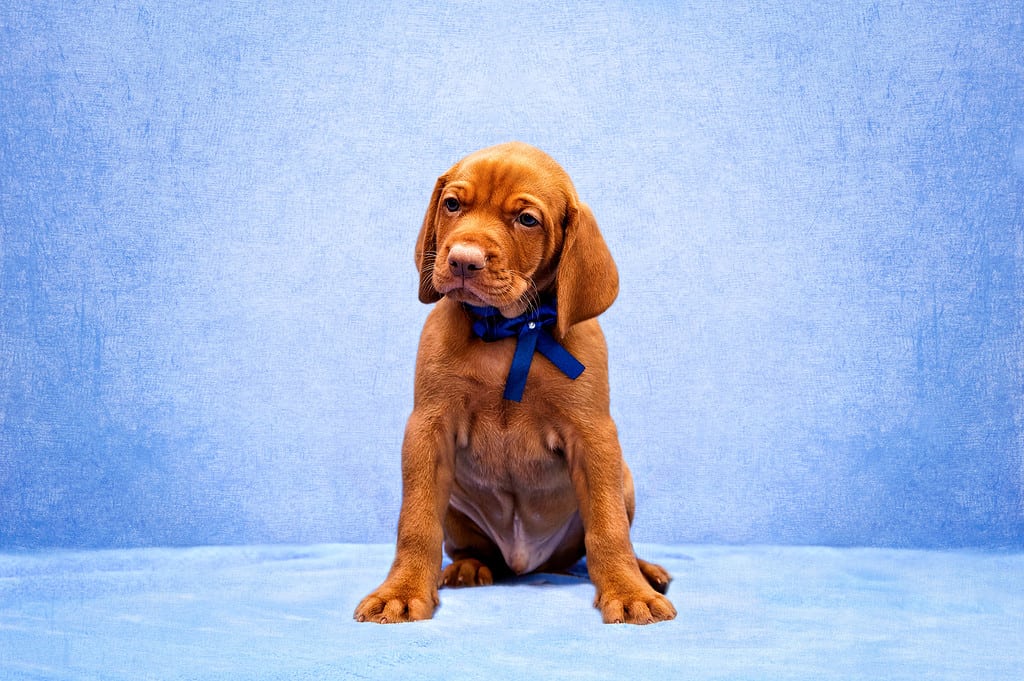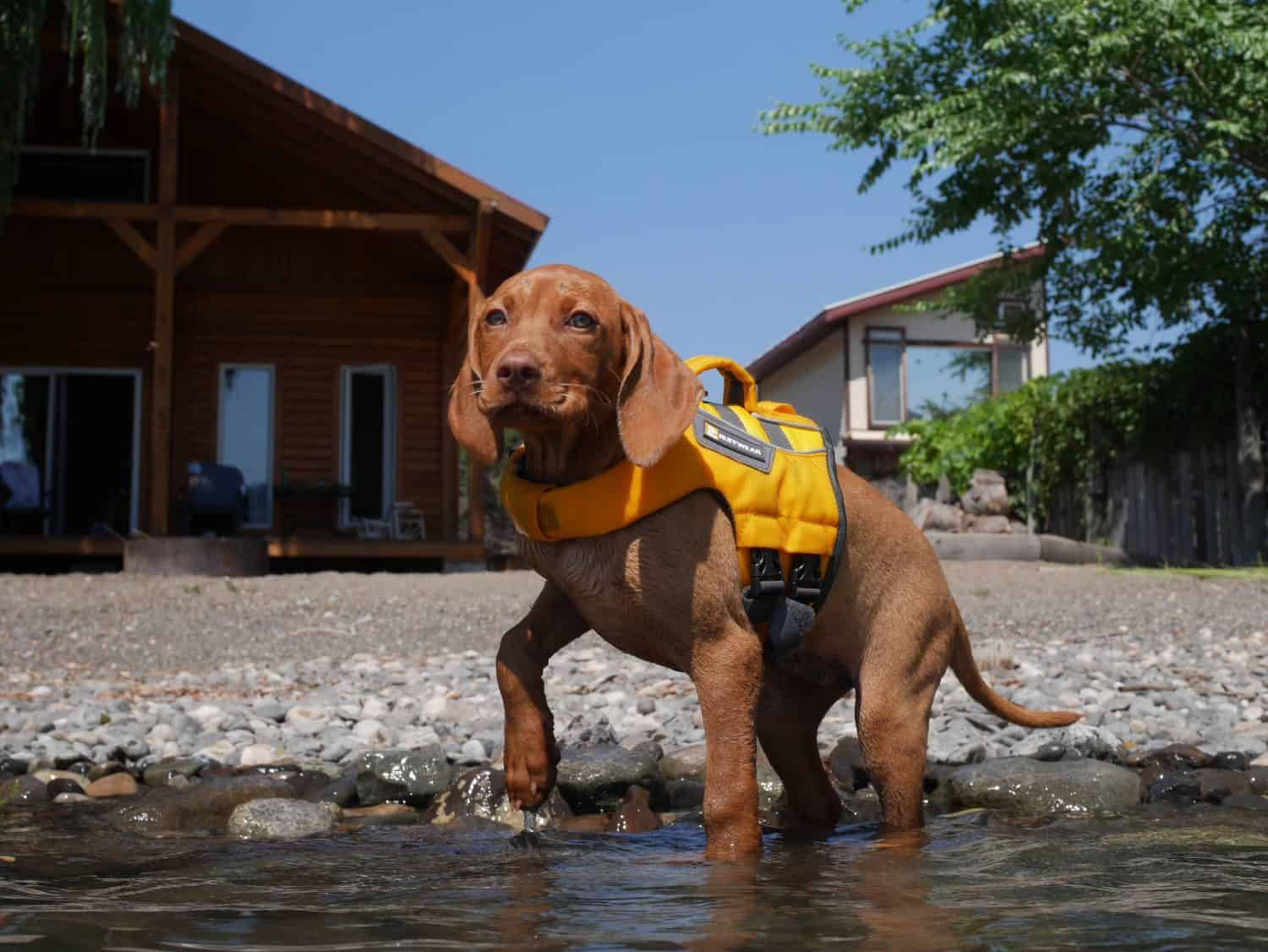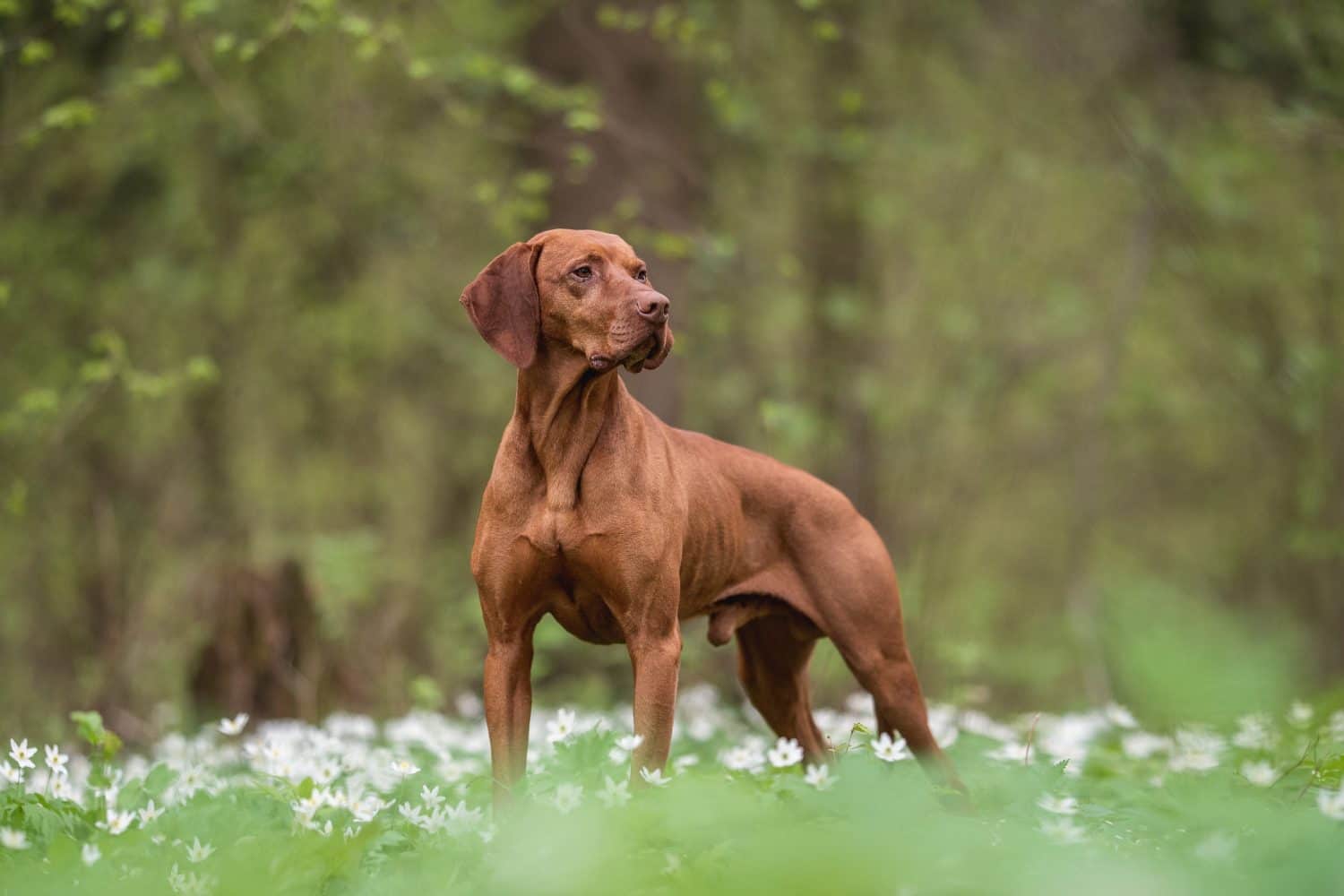Vizsla Summary
Vizslas are the ultimate sports dogs, with lean bodies and endless stamina. They were initially bred as rugged hunting dogs but are now more popular for their fierce loyalty and goofy enthusiasm than their keen sense of smell. Vizslas are also known for their distinctive silky red coats and big, floppy ears. These dogs love to be active and spend time with their owners. They need a lot of attention to flourish, but they offer sweet devotion in return. If you are a new owner, you might be curious if your vizsla progression is on target for proper growth.
Vizsla Growth and Weight Chart by Age
It’s impossible to predict the growth progression of a specific dog, but the table below will give you the weight ranges you might expect as your vizsla grows into an adult.
If you think your vizsla’s growth is too fast or slow, bring them to a vet. Some diseases and disorders affect growth.
| Age | Male Weight (lbs) | Female Weight (lbs) |
|---|---|---|
| Newborn | 0.5 – 1.5 | 0.4 – 1.2 |
| 2 months | 5 – 15 | 5 – 13 |
| 4 months | 15 – 26 | 11 – 19 |
| 6 months | 25 – 36 | 20 – 31 |
| 8 months | 35 – 46 | 28 – 39 |
| 10 months | 40 – 44 | 35 – 45 |
| 12 months | 45 – 50 | 41 – 50 |
| 14 months | 50 – 55 | 42 – 51 |
| 16 months | 55 – 58 | 44 – 53 |
| 18 months | 55 – 60 | 45 – 55 |
When Will My Vizsla Stop Growing?

Vizslas grow until they are 45 to 60 pounds on average.
©Ksenia Raykova/Shutterstock.com
Gorgeous, rust-colored vizslas grow like weeds for the first few months of their lives. The rapid growth slows by eight months and is nearly over when the dog reaches one. Your vizsla may gain a few more pounds between one and two years old, but it likely won’t be very noticeable.
Some vizslas have trouble gaining weight, and it may take a full two years for them to reach their full size. However, most vizslas stop growing by 18 months. There are no visible signs your vizsla is done growing. Check the appropriate weight range for their age and see where your pup is.
For example, a female vizsla that’s 16 months old and weighs 55 pounds is most likely done growing, while a female vizsla that’s the same age but only weighs 50 pounds may still add a pound or two.
How Big Will My Vizsla Be When It’s Fully Grown?
Experts consider the vizsla a medium-to-large dog. From floor to shoulder, they average between 21 to 24 inches long. If vizslas weren’t so slender, they would be firmly in the large dog category. However, adult females are usually slim at 45 to 55 pounds, while the average male vizslas reaches 55 to 60 pounds.
The Biggest Vizsla Ever Recorded
Most vizslas don’t stand out for their size. A special vizsla named Max, however, bucked the trend. Max was born in 2015 and was the biggest vizsla ever recorded. He weighed 85 pounds and stood 30 inches tall!
In addition to his striking visual appearance, Max also had a memorable personality. His owner, John Smith, explained that Max was incredibly gentle and loving.
When Should My Vizsla Be Spayed or Neutered?
Spaying or neutering your vizsla brings enormous benefits. Females can no longer become pregnant, which is what most pet owners desire. Caring for a pregnant vizsla and her subsequent puppies is a big task.
Spaying and neutering also help reduce behavior problems. The drive to mate is one of evolution’s biggest urges, changing how your dog interacts with the world. Unneutered males may be more aggressive, territorial, and harder to control, while unspayed females go into heat. Being in heat can involve aggression and irritability as hormone levels fluctuate.
Traditionally, vets recommend spaying or neutering all dogs as early as eight weeks to six months. However, that advice no longer applies to every dog. Now, vets know that early spaying and neutering can lead to health and growth problems in large, slow-growing dogs. The new recommendation for these dogs is to wait until they’re fully grown, if possible.
Waiting until maturity to spay or neuter your vizsla is only advisable if you’re in a situation where you can prevent the pup from getting pregnant or impregnating another.
When Should My Vizsla Be House Broken?
Going to the bathroom outside the house is one of the most critical skills you’ll teach your puppy, and you can start right away. Most breeders allow vizsla pups to go home to new owners at eight to ten weeks of age.
Here are a few key housetraining tips:
- Pick a spot: When you first start training, pick a designated spot outside for bathroom breaks. It’ll make it easier for the vizsla to make the connection that it’s potty time.
- Choose a phrase: Time for potty! Let’s go outside. Phrases like these alert your dog to what’s going to happen next. Just make sure that you choose a phrase you don’t mind saying all the time.
- Reward: Shower your vizsla with praise and congratulations when they’re successful. They love pleasing you, and your happiness provides extra motivation.
- Stay consistent: Consistency matters in the first few weeks. Your puppy may get confused with changing preferences.
To train your dog as fast as possible, bathroom breaks should occur every two hours. Very young puppies go to the bathroom often, and you want to minimize the chance of accidents. If an accident does occur, never get angry. You don’t want to terrify your furry friend.
Instead, take them outside if you catch them. If you stumble upon an accident when the dog isn’t around, there’s nothing you can do. Dragging your pup back to the “scene of the crime” just confuses them.
Vizslas are intelligent, but it can take a few months for your dog to become 100% housebroken. Be patient, and remember the frequent potty breaks.
When Should My Vizsla Stop Eating Puppy Food?
Don’t be fooled by their lithe physique. Vizlas are highly active dogs with huge appetites, and that’s especially apparent while they’re young. Your brand-new, eight-week-old vizsla can chow down on as much as two cups of puppy food per day.
Your vizsla can thrive on puppy food for the first eight to twelve months of their lives. However, by the time they’re one year old, they need to stop eating puppy food and switch to a diet with a different nutrient profile. Adult vizslas need slightly more protein than puppies.
When you’re ready to make the switch, go slow. Mix some new food with the puppy food so your dog gets used to the taste.
When Will My Vizsla Start Losing Teeth?
Expect your vizsla puppy to start losing their 28 puppy teeth when they are around four to six months old. Their 42 adult teeth come in shortly after. It’s a big process, and you’ll know it’s happening because your vizsla might turn into a little teething terror. Puppies in this state love to chew on everything from your hand to your favorite shoes.
Teething puppies don’t have to be destructive, however. Just make sure you provide plenty of chewable toys that aren’t your belongings.
When Should I Start Training My Vizsla?
Vizslas are ready for training on day one. They’re clever dogs with active brains and high athleticism. Letting them sit idly for weeks while they get used to your home can actually be harmful. Vizslas need constant stimulation as well as strict boundaries. Failing to provide in either of these respects might cause your vizsla to act out and ravage its surroundings. They’ll dig up the carpet, chew on furniture, and exhibit other unwanted stress behaviors.
You need to keep your vizsla entertained, but it shouldn’t be a full-time job. You also need to teach the dog how to be alone. This training should start as early as possible because it contradicts your vizsla’s natural social inclinations. Untrained or poorly trained vizslas can be very clingy.
Vizslas love trotting alongside their owners on long jogs and bike rides, so it’s a good idea to start taking them out as a puppy if you’re a jogger or biker. They’ll learn how to keep pace with and run with a leash.
What Commands Should I Teach My Vizsla First?
Your vizsla is eager and ready to learn your commands. But you shouldn’t overload them at the start. Keep it simple and begin your training regimen with a few simple commands. These commands will help you train the dog further.
- Come: When you call your dog’s name, you want them to come to your side at once. It may be for a frivolous reason, like wanting to pet their sleek fur, or for a more serious purpose, like calling them from danger. You’ll use this command for the rest of the dog’s life.
- Stay: Vizsla puppies burst with energy and can hardly keep still. The “stay” command teaches them to sit still when needed.
- Sit: Every dog should learn how to sit. It keeps them in one spot and helps calm them down. It’s very handy when you can tell an over-excited dog to sit, and they obey.
When Will My Vizsla Calm Down?
A boisterous vizsla may be fully grown by 14 months, but it would be surprising if they didn’t still have their puppy energy. Vizslas are energetic working dogs that typically play like puppies until they’re two or three years old.
And when your vizsla does calm down, they won’t suddenly become sedentary. Vizlas got their start working with Hungarian hunters. They were bred to withstand long, physically demanding treks through woods and plains. Many vizslas retain their high-energy personality until old age or illness hits.
A calm vizsla is simply less likely to engage in destructive behaviors.
Common Health Issues Your Vizsla Might Experience
Every dog breed is prone to health problems, and vizslas are no exception. The health issues that might afflict your vizsla include:
- Obesity: As working dogs, vizslas need at least two thirty-minute exercise sessions daily. If they don’t get their recommended exercise, they often fall prey to obesity. You can combat this with regular long walks, plenty of playtime, and a vet-approved, balanced diet.
- Separation anxiety: Vizslas like to be close to their people. This can sometimes turn into separation anxiety.
- Von Willebrand’s Disease: Von Willebrand’s disease is a blood clotting problem that can trigger uncontrollable bleeding.
- Hip and Elbow Dysplasia: Joint dysplasia is common in large purebred dogs.
Pictures of Vizslas as Puppies

Vizsla puppies grow rapidly from birth to eight months old or so. They then grow slowly until they reach their final weight.
©iStock.com/Natalia Miachikova
Pictures of Vizsla at 6 Months

Confident vizslas are ready to explore while they’re still puppies.
©Rylen M/Shutterstock.com

People admire vizslas’ regal appearance.
©Liudmila Bohush/Shutterstock.com
Other Dog Breeds Similar to Vizlas
Ready to discover the top 10 cutest dog breeds in the entire world?
How about the fastest dogs, the largest dogs and those that are -- quite frankly -- just the kindest dogs on the planet? Each day, AZ Animals sends out lists just like this to our thousands of email subscribers. And the best part? It's FREE. Join today by entering your email below.
Thank you for reading! Have some feedback for us? Contact the AZ Animals editorial team.








